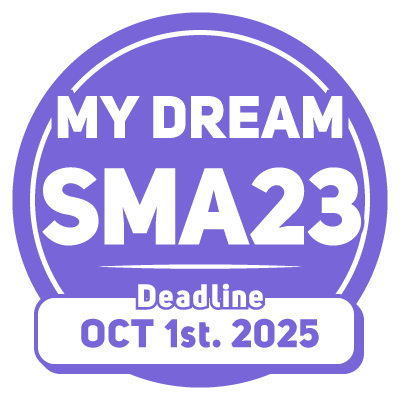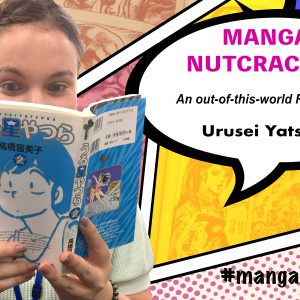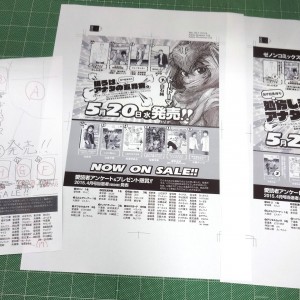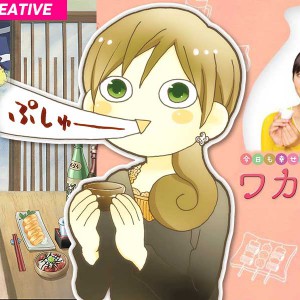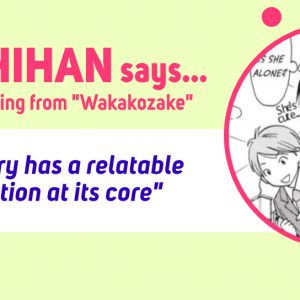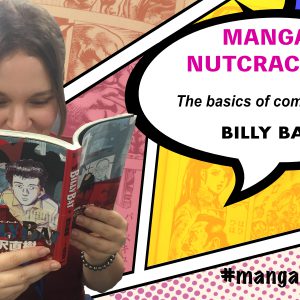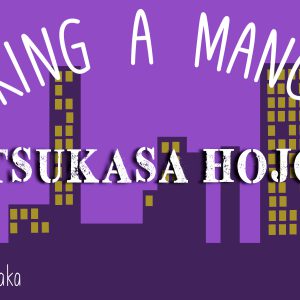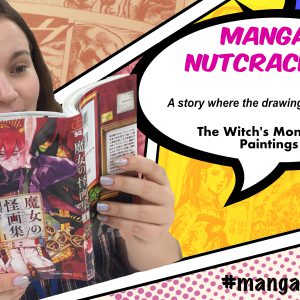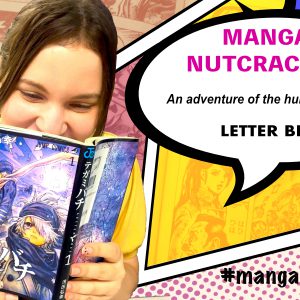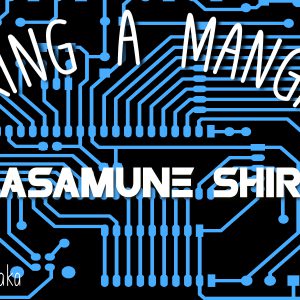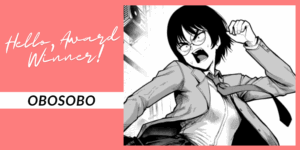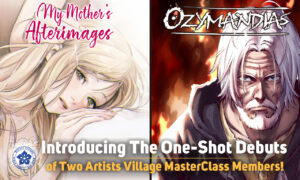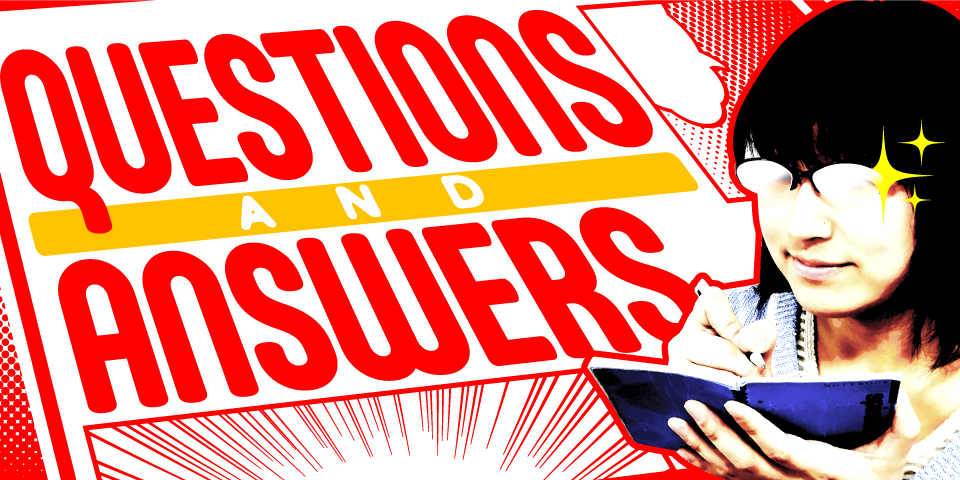
Hi everyone! As I mentioned last time, today we’re doing a Q&A session!
Thank you so much for all the your questions and comments! They really give me the energy to continue writing 🙂
Okay, let’s begin!
 – Is it possible to do mochikomi over the internet? (Ivan Radev)
Unfortunately, accepting mochikomi via the internet is not a common practice in the manga industry today.
It is technically possible to send us your manga online, but as Mr. Akiyama mentioned in MANGA INSIDER MAYU #15: “working together with an editor in the same space breathes new life into a piece”. This is an essential part of the creative process.
I see this way of thinking to be the mainstream for the foreseeable future. (That’s why we invite the masterclass members to Japan, so we can talk to them face-to-face.) I can honestly say that winning an award on SMA is the closest thing to doing a “Mochikomi over the internet”, as each entry will be thoroughly and deeply assessed by our team of seasoned manga professionals.
However if you are ever in Japan, and want to do a mochikomi, by all means give us a call!
– Is it possible to do mochikomi over the internet? (Ivan Radev)
Unfortunately, accepting mochikomi via the internet is not a common practice in the manga industry today.
It is technically possible to send us your manga online, but as Mr. Akiyama mentioned in MANGA INSIDER MAYU #15: “working together with an editor in the same space breathes new life into a piece”. This is an essential part of the creative process.
I see this way of thinking to be the mainstream for the foreseeable future. (That’s why we invite the masterclass members to Japan, so we can talk to them face-to-face.) I can honestly say that winning an award on SMA is the closest thing to doing a “Mochikomi over the internet”, as each entry will be thoroughly and deeply assessed by our team of seasoned manga professionals.
However if you are ever in Japan, and want to do a mochikomi, by all means give us a call!
 – Is it possible for a person over 30 to debut as a manga artist? (Haime Jnp, Kuroi Kai)
This may surprise a few people, but there’s no problem at all! Encouragingly there are many senpai’s who debuted after turning 30. Especially with monthly magazines or seinen manga magazines, there are many artists who did just that, debuting after 30. Here at ZENON, we had our share of artists who debuted at a ripe old age!
However, when it comes to weekly magazines and shonen manga magazines, the younger you are, the more likely to win an award and a chance to make that a debut.
At the end of the day, you have to look at the average age of the readers (younger artist are more likely to connect with younger readers). That being said, this year there was a 52 year old who won the Chiba Tetsuya Award. Talent has nothing to do with age!
– Is it possible for a person over 30 to debut as a manga artist? (Haime Jnp, Kuroi Kai)
This may surprise a few people, but there’s no problem at all! Encouragingly there are many senpai’s who debuted after turning 30. Especially with monthly magazines or seinen manga magazines, there are many artists who did just that, debuting after 30. Here at ZENON, we had our share of artists who debuted at a ripe old age!
However, when it comes to weekly magazines and shonen manga magazines, the younger you are, the more likely to win an award and a chance to make that a debut.
At the end of the day, you have to look at the average age of the readers (younger artist are more likely to connect with younger readers). That being said, this year there was a 52 year old who won the Chiba Tetsuya Award. Talent has nothing to do with age!

 – Which do editors prefer, digital or real? Do digital artist have a chance for making manga, although they don’t know drawing techniques? (Haime Jnp)
The short answer is that the editors seriously don’t care! Many editors, including our chief editor Mr. Mochida, believe that a computer is just a tool. The artist should use whatever they’re most comfortable with, whether that’s a pen or a brush, physical or virtual. There’s no reason that an editor should interfere with this.
One issue I could point out, is that computers are fundamentally designed to “increase productivity”. While there is absolutely nothing wrong with keeping tedious tasks to a minimum, it can also be used to “cut corners” way too easily.
The readers will be able to discern if an artist cuts corners in their work, or “not being sincere with the intent to entertain”. As such, the editor needs to be careful when an artist works with digital tools.
So here’s a recap, there is “Nothing wrong with working digital or analogue”. The problem however;- if there is one – is “Not doing your best for the readers”!
– Which do editors prefer, digital or real? Do digital artist have a chance for making manga, although they don’t know drawing techniques? (Haime Jnp)
The short answer is that the editors seriously don’t care! Many editors, including our chief editor Mr. Mochida, believe that a computer is just a tool. The artist should use whatever they’re most comfortable with, whether that’s a pen or a brush, physical or virtual. There’s no reason that an editor should interfere with this.
One issue I could point out, is that computers are fundamentally designed to “increase productivity”. While there is absolutely nothing wrong with keeping tedious tasks to a minimum, it can also be used to “cut corners” way too easily.
The readers will be able to discern if an artist cuts corners in their work, or “not being sincere with the intent to entertain”. As such, the editor needs to be careful when an artist works with digital tools.
So here’s a recap, there is “Nothing wrong with working digital or analogue”. The problem however;- if there is one – is “Not doing your best for the readers”!
 – Is it necessary to speak Japanese if he already knows about Japanese culture? (Hime Sama)
If you want to work in the Japanese manga industry in the traditional sense, then you really need to be comfortable communicating in Japanese. In Japan, the only compulsory secondary language is English, and most people struggle with that. As such, creative meetings will happen almost exclusively in Japanese.
We’re glad to hear that you have interests and understandings in Japanese culture, but that alone won’t be enough to secure a job. Realistically, if you take your work to any editorial team other than SMAC!, you’ll need a certain level of fluency in Japanese.
– Is it necessary to speak Japanese if he already knows about Japanese culture? (Hime Sama)
If you want to work in the Japanese manga industry in the traditional sense, then you really need to be comfortable communicating in Japanese. In Japan, the only compulsory secondary language is English, and most people struggle with that. As such, creative meetings will happen almost exclusively in Japanese.
We’re glad to hear that you have interests and understandings in Japanese culture, but that alone won’t be enough to secure a job. Realistically, if you take your work to any editorial team other than SMAC!, you’ll need a certain level of fluency in Japanese.
 – Is there a chance for foreign manga artists to work in the Japanese manga industry as a pro or assistant? How? (Fanni Fanfan, Hime Sama, )
Why not! Everybody has a chance, fair and square. In fact, Hara-sensei once had a assistant from abroad (who worked through an interpreter), and there are manga artists from China, Korea, Spain and Sweden working in Japan right now, successfully may I add.
To succeed as a manga artist in Japan, you need excellent artistic skills for manga creation, and communication skills for getting by and talking with your editor.
As for living as “foreigner” in Japan, I asked my colleague Andrew, who is doing just that. He says you need “a visa, a place to live, and a sense of humour”. Stay positive, and you’ll find a way!
(The rules for visas differ depending on your area, it would be best to ask a local specialist, such as the Japanese embassy or a career consultant in your country.)
– Is there a chance for foreign manga artists to work in the Japanese manga industry as a pro or assistant? How? (Fanni Fanfan, Hime Sama, )
Why not! Everybody has a chance, fair and square. In fact, Hara-sensei once had a assistant from abroad (who worked through an interpreter), and there are manga artists from China, Korea, Spain and Sweden working in Japan right now, successfully may I add.
To succeed as a manga artist in Japan, you need excellent artistic skills for manga creation, and communication skills for getting by and talking with your editor.
As for living as “foreigner” in Japan, I asked my colleague Andrew, who is doing just that. He says you need “a visa, a place to live, and a sense of humour”. Stay positive, and you’ll find a way!
(The rules for visas differ depending on your area, it would be best to ask a local specialist, such as the Japanese embassy or a career consultant in your country.)
 – Has there ever been a foreigner manga artist/assistant who lived outside of Japan and worked for a Japanese publisher? (Fanni Fanfan)
There have been Japanese manga artists who have published manga in Comic ZENON while living overseas. Those artists used Skype to communicate with their editors.
While it’s not “unheard of”, it’s extremely rare for a foreign manga artist to publish something in Japan while living outside of it.
– Has there ever been a foreigner manga artist/assistant who lived outside of Japan and worked for a Japanese publisher? (Fanni Fanfan)
There have been Japanese manga artists who have published manga in Comic ZENON while living overseas. Those artists used Skype to communicate with their editors.
While it’s not “unheard of”, it’s extremely rare for a foreign manga artist to publish something in Japan while living outside of it.
 However, that is exactly the situation we are trying to change with SMAC!. Through SILENT MANGA AUDITION, we want to build working relationships with artists living in various countries. We have high hopes for the future!
However, that is exactly the situation we are trying to change with SMAC!. Through SILENT MANGA AUDITION, we want to build working relationships with artists living in various countries. We have high hopes for the future!
 – How do the artists of long-running series keep up their work? Is it necessary for manga artists to improvise the plots for new chapters? (Kuroi Kai)
As previously mentioned, since the early days of Weekly JUMP, many manga magazines take reader surveys, which they then use to decide the length of publication. Regardless of the original plan, a popular manga will run for a longer period, and an unpopular manga may be cut off halfway. An artist must be flexible and be able to adapt to those changes.
Many people may wonder “Don’t they run out of ideas?” As I mentioned in the previous article, it’s the editor’s job to make sure the artist never runs out of ideas!
– How do the artists of long-running series keep up their work? Is it necessary for manga artists to improvise the plots for new chapters? (Kuroi Kai)
As previously mentioned, since the early days of Weekly JUMP, many manga magazines take reader surveys, which they then use to decide the length of publication. Regardless of the original plan, a popular manga will run for a longer period, and an unpopular manga may be cut off halfway. An artist must be flexible and be able to adapt to those changes.
Many people may wonder “Don’t they run out of ideas?” As I mentioned in the previous article, it’s the editor’s job to make sure the artist never runs out of ideas!
 Combining the artist’s own ideas, and the input from the editor, an artist should have enough inspiration to keep going!
Combining the artist’s own ideas, and the input from the editor, an artist should have enough inspiration to keep going!
 – How does a horror manga series go, in terms of usage of gory images and issues of beliefs? (Kristine Arante)
Mr. Watanabe’s opinion is “The whole point of horror manga is to scare the reader. That element is essential. So if necessary, gory images and religious themes can be used.” On the other hand, Mr. Mochida says “Certain extreme themes such as cannibalism or racism will not be permitted under any circumstances.”
So it’s a bit more difficult to judge when it comes to horror manga. Lastly, our head honcho Horie-san says “A manga is worthless if it doesn’t make somebody happy”.
At the end of the day, how you interpret those wise words of our senpais is up to you.
– How does a horror manga series go, in terms of usage of gory images and issues of beliefs? (Kristine Arante)
Mr. Watanabe’s opinion is “The whole point of horror manga is to scare the reader. That element is essential. So if necessary, gory images and religious themes can be used.” On the other hand, Mr. Mochida says “Certain extreme themes such as cannibalism or racism will not be permitted under any circumstances.”
So it’s a bit more difficult to judge when it comes to horror manga. Lastly, our head honcho Horie-san says “A manga is worthless if it doesn’t make somebody happy”.
At the end of the day, how you interpret those wise words of our senpais is up to you.
 – What happens if the artist can’t meet their deadline? (Vanilla)
No matter how hard the artist and editor work, there are times when they just can’t meet the deadline. In our line of business, we call this “genkou wo otosu” (literally “to drop the manuscript”). In this case, we might publish up to where the artist has finished, with an apology note, or we might fill the space with a “daigen” (a substitute manga”). Interestingly, there have been several successful series that started as a daigen, and went on to become anime or dramas!
So that’s a summary of “What happens”. As for “What happens to the artist”, we hear there is a demon that walks at night, beheading those late submitters… rumours rumours…
– What happens if the artist can’t meet their deadline? (Vanilla)
No matter how hard the artist and editor work, there are times when they just can’t meet the deadline. In our line of business, we call this “genkou wo otosu” (literally “to drop the manuscript”). In this case, we might publish up to where the artist has finished, with an apology note, or we might fill the space with a “daigen” (a substitute manga”). Interestingly, there have been several successful series that started as a daigen, and went on to become anime or dramas!
So that’s a summary of “What happens”. As for “What happens to the artist”, we hear there is a demon that walks at night, beheading those late submitters… rumours rumours…
 – Has any of the ZENON editors had an artist run away? (Pedes Typo)
This happens more often than you would think (or we’d like!). Our chief editor Mr. Mochida has had a certain famous artist run out on him, right in the middle of work. The artist left saying “I’m going to go buy some cigarettes”… and then disappeared without trace. 3 days later, the artist turned up again without notice, and declared that he would continue drawing the manga…
There are even some editors who “camp out” in the artist’s studio so they can be on hand to receive the finished work as soon as it’s ready. Even so, if the artist wants to make a run for it, there’s not that much you can do…
“Running away” might also refer to publishing a work in another magazine. However, drawing manga is a freelance job. Unless an artist signs an “Exclusive contract”, he is perfectly within his rights to publish work elsewhere. We have several artists at ZENON who are drawing for multiple magazines at the same time: Kajio-sensei (DD Hokuto no Ken), Takase-sensei (Otoriyose Ouji), Toei-sensei (Concierge Imperial), Yokoyama-sensei (Manga Senmon Gakkou no Seishun) and Megurogawa-sensei (Oda Cinnamon Nobunaga).
If you like their work here (which will be available in the future here on SMAC!) then you may want to look for their other work elsewhere too 🙂
– Has any of the ZENON editors had an artist run away? (Pedes Typo)
This happens more often than you would think (or we’d like!). Our chief editor Mr. Mochida has had a certain famous artist run out on him, right in the middle of work. The artist left saying “I’m going to go buy some cigarettes”… and then disappeared without trace. 3 days later, the artist turned up again without notice, and declared that he would continue drawing the manga…
There are even some editors who “camp out” in the artist’s studio so they can be on hand to receive the finished work as soon as it’s ready. Even so, if the artist wants to make a run for it, there’s not that much you can do…
“Running away” might also refer to publishing a work in another magazine. However, drawing manga is a freelance job. Unless an artist signs an “Exclusive contract”, he is perfectly within his rights to publish work elsewhere. We have several artists at ZENON who are drawing for multiple magazines at the same time: Kajio-sensei (DD Hokuto no Ken), Takase-sensei (Otoriyose Ouji), Toei-sensei (Concierge Imperial), Yokoyama-sensei (Manga Senmon Gakkou no Seishun) and Megurogawa-sensei (Oda Cinnamon Nobunaga).
If you like their work here (which will be available in the future here on SMAC!) then you may want to look for their other work elsewhere too 🙂
 – How often do the editors in Comic ZENON or any Manga Magazines sit down and explore ideas with current/aspiring mangakas in a given month, in regards to one-shots? (David Azurin Vijandre)
It’s hard to say exactly. The exact amount of meetings depends on the artist’s schedule (Tsukasa Hojo sensei, for example, has 2 meetings a month, each taking about 2 hours).
However, the “ideal editor” is always on the look out for potential ideas that his artists could use, 24/7! We observe, gather, think, and think some more… and suggest all the ideas that we come up with, until the manga artists figures out the ultimate answer.
– How often do the editors in Comic ZENON or any Manga Magazines sit down and explore ideas with current/aspiring mangakas in a given month, in regards to one-shots? (David Azurin Vijandre)
It’s hard to say exactly. The exact amount of meetings depends on the artist’s schedule (Tsukasa Hojo sensei, for example, has 2 meetings a month, each taking about 2 hours).
However, the “ideal editor” is always on the look out for potential ideas that his artists could use, 24/7! We observe, gather, think, and think some more… and suggest all the ideas that we come up with, until the manga artists figures out the ultimate answer.
 – How do editors point out problems without discouraging the artist? (Pedes Typo)
It’s not that there’s a specific trick to it. Just like in any business, a solid relationship is the key to success. The editor and the artist, first build a trusting relationship as a team.
Sincerity and honesty are a virtue in any working team, so editors never give false praise or tell the artist what he wants to hear.
You could say that always being honest, and faithfully supporting the artist is the only “trick”. Gathering data and ideas for the artist, and helping in whatever way necessary so that the artist can develop his ideas will contribute to building a strong, trusting relationship.
Once you have a good, working relationship, it’s that much easier to point out each other’s flaws for improvement, or exchange honest opinions, with no hard feelings.
– How do editors point out problems without discouraging the artist? (Pedes Typo)
It’s not that there’s a specific trick to it. Just like in any business, a solid relationship is the key to success. The editor and the artist, first build a trusting relationship as a team.
Sincerity and honesty are a virtue in any working team, so editors never give false praise or tell the artist what he wants to hear.
You could say that always being honest, and faithfully supporting the artist is the only “trick”. Gathering data and ideas for the artist, and helping in whatever way necessary so that the artist can develop his ideas will contribute to building a strong, trusting relationship.
Once you have a good, working relationship, it’s that much easier to point out each other’s flaws for improvement, or exchange honest opinions, with no hard feelings.
 – What’s it like being an editor (as a career)? (Spectre)
To put it simply, an editor is just a company employee. The salary depends on the scale of the company, and how many years the editor has worked there. If you work for a big publisher, are gifted, and have a strong relationship with a talented artist, then you could earn 10,000,000+ yen annual income (roughly 80k+ USD).
On the other hand, the work is highly diversified, and can be super hectic! Sometimes you can’t go home for days, because you have to pull all-nighters at the office!
Since this is a satisfying job with a good salary, competition for positions is very fierce. As such, editors who have joined the company through the most common route (Shinsotsu Saiyo) usually have a very good academic record. (of course, as introduced in MANGA INSIDER MAYU #6, you can work your way up as a part-timer)
An editor’s career is judged by the number and quality of series that he has helped to create. So a talented editor who has produced many hit series might aim higher by moving to a larger company, or begin working independently. After moving away from the front lines, they could set up an agent company that deals in manga rights, work freelance or work in a related field. ( By the way, our president Mr. Horie, is considered the only man in Japan who retired as an editor, and then started his own manga magazine! He knows a thing or two about “Being an editor” 😉 )
– What’s it like being an editor (as a career)? (Spectre)
To put it simply, an editor is just a company employee. The salary depends on the scale of the company, and how many years the editor has worked there. If you work for a big publisher, are gifted, and have a strong relationship with a talented artist, then you could earn 10,000,000+ yen annual income (roughly 80k+ USD).
On the other hand, the work is highly diversified, and can be super hectic! Sometimes you can’t go home for days, because you have to pull all-nighters at the office!
Since this is a satisfying job with a good salary, competition for positions is very fierce. As such, editors who have joined the company through the most common route (Shinsotsu Saiyo) usually have a very good academic record. (of course, as introduced in MANGA INSIDER MAYU #6, you can work your way up as a part-timer)
An editor’s career is judged by the number and quality of series that he has helped to create. So a talented editor who has produced many hit series might aim higher by moving to a larger company, or begin working independently. After moving away from the front lines, they could set up an agent company that deals in manga rights, work freelance or work in a related field. ( By the way, our president Mr. Horie, is considered the only man in Japan who retired as an editor, and then started his own manga magazine! He knows a thing or two about “Being an editor” 😉 )
 – What are the editors most afraid of? (Pedes Typo)
For an editor, the most terrifying thing is… missing the dreadline! This will result in us being yelled at by the printers and agencies, and more than anything else, we’ll face the displeasure of the readers. This is definitely an outcome that both the artist and the editor want to avoid. So just thinking about missing a deadline makes us break out in cold sweat… The next most scary thing is : Typo’s. Although sometimes unavoidable, this is something else that disappoints the readers.
The most terrifying situation that Mr. Mochida has ever experienced was: a certain popular artist was scheduled to drawing the cover illustration for the magazine but… although the artist did complete that cover art, he didn’t have enough time to complete his own manga… How terrible…! ( When someones buys a magazine for the cover art, it’s only natural that he expects to read the title work! Imagine the grievance….)
Hope that answer your questions?
Thanks to your continued support, this series has already reached its 20th article! Thank you for all your comments and questions!
It’s really makes my day to know that I can tell everyone about an editor’s job. And every comment motivates me to try even harder!
MANGA INSIDER MAYU will continue to provide you with behind the scenes information about an editor’s work!
Since we’re going to be starting SMAC! Web Magazine in earnest from next month, I might not be able to publish articles as regularly as before, but I will keep doing my best! Hope for your continuing support!
For those who couldn’t find your question… Some of the following questions will be covered in future articles!
Those are:
– What are the editors most afraid of? (Pedes Typo)
For an editor, the most terrifying thing is… missing the dreadline! This will result in us being yelled at by the printers and agencies, and more than anything else, we’ll face the displeasure of the readers. This is definitely an outcome that both the artist and the editor want to avoid. So just thinking about missing a deadline makes us break out in cold sweat… The next most scary thing is : Typo’s. Although sometimes unavoidable, this is something else that disappoints the readers.
The most terrifying situation that Mr. Mochida has ever experienced was: a certain popular artist was scheduled to drawing the cover illustration for the magazine but… although the artist did complete that cover art, he didn’t have enough time to complete his own manga… How terrible…! ( When someones buys a magazine for the cover art, it’s only natural that he expects to read the title work! Imagine the grievance….)
Hope that answer your questions?
Thanks to your continued support, this series has already reached its 20th article! Thank you for all your comments and questions!
It’s really makes my day to know that I can tell everyone about an editor’s job. And every comment motivates me to try even harder!
MANGA INSIDER MAYU will continue to provide you with behind the scenes information about an editor’s work!
Since we’re going to be starting SMAC! Web Magazine in earnest from next month, I might not be able to publish articles as regularly as before, but I will keep doing my best! Hope for your continuing support!
For those who couldn’t find your question… Some of the following questions will be covered in future articles!
Those are:
 – Is it possible to do mochikomi over the internet? (Ivan Radev)
Unfortunately, accepting mochikomi via the internet is not a common practice in the manga industry today.
It is technically possible to send us your manga online, but as Mr. Akiyama mentioned in MANGA INSIDER MAYU #15: “working together with an editor in the same space breathes new life into a piece”. This is an essential part of the creative process.
I see this way of thinking to be the mainstream for the foreseeable future. (That’s why we invite the masterclass members to Japan, so we can talk to them face-to-face.) I can honestly say that winning an award on SMA is the closest thing to doing a “Mochikomi over the internet”, as each entry will be thoroughly and deeply assessed by our team of seasoned manga professionals.
However if you are ever in Japan, and want to do a mochikomi, by all means give us a call!
– Is it possible to do mochikomi over the internet? (Ivan Radev)
Unfortunately, accepting mochikomi via the internet is not a common practice in the manga industry today.
It is technically possible to send us your manga online, but as Mr. Akiyama mentioned in MANGA INSIDER MAYU #15: “working together with an editor in the same space breathes new life into a piece”. This is an essential part of the creative process.
I see this way of thinking to be the mainstream for the foreseeable future. (That’s why we invite the masterclass members to Japan, so we can talk to them face-to-face.) I can honestly say that winning an award on SMA is the closest thing to doing a “Mochikomi over the internet”, as each entry will be thoroughly and deeply assessed by our team of seasoned manga professionals.
However if you are ever in Japan, and want to do a mochikomi, by all means give us a call!
 – Is it possible for a person over 30 to debut as a manga artist? (Haime Jnp, Kuroi Kai)
This may surprise a few people, but there’s no problem at all! Encouragingly there are many senpai’s who debuted after turning 30. Especially with monthly magazines or seinen manga magazines, there are many artists who did just that, debuting after 30. Here at ZENON, we had our share of artists who debuted at a ripe old age!
However, when it comes to weekly magazines and shonen manga magazines, the younger you are, the more likely to win an award and a chance to make that a debut.
At the end of the day, you have to look at the average age of the readers (younger artist are more likely to connect with younger readers). That being said, this year there was a 52 year old who won the Chiba Tetsuya Award. Talent has nothing to do with age!
– Is it possible for a person over 30 to debut as a manga artist? (Haime Jnp, Kuroi Kai)
This may surprise a few people, but there’s no problem at all! Encouragingly there are many senpai’s who debuted after turning 30. Especially with monthly magazines or seinen manga magazines, there are many artists who did just that, debuting after 30. Here at ZENON, we had our share of artists who debuted at a ripe old age!
However, when it comes to weekly magazines and shonen manga magazines, the younger you are, the more likely to win an award and a chance to make that a debut.
At the end of the day, you have to look at the average age of the readers (younger artist are more likely to connect with younger readers). That being said, this year there was a 52 year old who won the Chiba Tetsuya Award. Talent has nothing to do with age!

Miyama Sango sensei, at the age of 52, won the grand prix for the 67th Tetsuya Chiba award, and had his manga published on a magazine!
 – Which do editors prefer, digital or real? Do digital artist have a chance for making manga, although they don’t know drawing techniques? (Haime Jnp)
The short answer is that the editors seriously don’t care! Many editors, including our chief editor Mr. Mochida, believe that a computer is just a tool. The artist should use whatever they’re most comfortable with, whether that’s a pen or a brush, physical or virtual. There’s no reason that an editor should interfere with this.
One issue I could point out, is that computers are fundamentally designed to “increase productivity”. While there is absolutely nothing wrong with keeping tedious tasks to a minimum, it can also be used to “cut corners” way too easily.
The readers will be able to discern if an artist cuts corners in their work, or “not being sincere with the intent to entertain”. As such, the editor needs to be careful when an artist works with digital tools.
So here’s a recap, there is “Nothing wrong with working digital or analogue”. The problem however;- if there is one – is “Not doing your best for the readers”!
– Which do editors prefer, digital or real? Do digital artist have a chance for making manga, although they don’t know drawing techniques? (Haime Jnp)
The short answer is that the editors seriously don’t care! Many editors, including our chief editor Mr. Mochida, believe that a computer is just a tool. The artist should use whatever they’re most comfortable with, whether that’s a pen or a brush, physical or virtual. There’s no reason that an editor should interfere with this.
One issue I could point out, is that computers are fundamentally designed to “increase productivity”. While there is absolutely nothing wrong with keeping tedious tasks to a minimum, it can also be used to “cut corners” way too easily.
The readers will be able to discern if an artist cuts corners in their work, or “not being sincere with the intent to entertain”. As such, the editor needs to be careful when an artist works with digital tools.
So here’s a recap, there is “Nothing wrong with working digital or analogue”. The problem however;- if there is one – is “Not doing your best for the readers”!
 – Is it necessary to speak Japanese if he already knows about Japanese culture? (Hime Sama)
If you want to work in the Japanese manga industry in the traditional sense, then you really need to be comfortable communicating in Japanese. In Japan, the only compulsory secondary language is English, and most people struggle with that. As such, creative meetings will happen almost exclusively in Japanese.
We’re glad to hear that you have interests and understandings in Japanese culture, but that alone won’t be enough to secure a job. Realistically, if you take your work to any editorial team other than SMAC!, you’ll need a certain level of fluency in Japanese.
– Is it necessary to speak Japanese if he already knows about Japanese culture? (Hime Sama)
If you want to work in the Japanese manga industry in the traditional sense, then you really need to be comfortable communicating in Japanese. In Japan, the only compulsory secondary language is English, and most people struggle with that. As such, creative meetings will happen almost exclusively in Japanese.
We’re glad to hear that you have interests and understandings in Japanese culture, but that alone won’t be enough to secure a job. Realistically, if you take your work to any editorial team other than SMAC!, you’ll need a certain level of fluency in Japanese.
 – Is there a chance for foreign manga artists to work in the Japanese manga industry as a pro or assistant? How? (Fanni Fanfan, Hime Sama, )
Why not! Everybody has a chance, fair and square. In fact, Hara-sensei once had a assistant from abroad (who worked through an interpreter), and there are manga artists from China, Korea, Spain and Sweden working in Japan right now, successfully may I add.
To succeed as a manga artist in Japan, you need excellent artistic skills for manga creation, and communication skills for getting by and talking with your editor.
As for living as “foreigner” in Japan, I asked my colleague Andrew, who is doing just that. He says you need “a visa, a place to live, and a sense of humour”. Stay positive, and you’ll find a way!
(The rules for visas differ depending on your area, it would be best to ask a local specialist, such as the Japanese embassy or a career consultant in your country.)
– Is there a chance for foreign manga artists to work in the Japanese manga industry as a pro or assistant? How? (Fanni Fanfan, Hime Sama, )
Why not! Everybody has a chance, fair and square. In fact, Hara-sensei once had a assistant from abroad (who worked through an interpreter), and there are manga artists from China, Korea, Spain and Sweden working in Japan right now, successfully may I add.
To succeed as a manga artist in Japan, you need excellent artistic skills for manga creation, and communication skills for getting by and talking with your editor.
As for living as “foreigner” in Japan, I asked my colleague Andrew, who is doing just that. He says you need “a visa, a place to live, and a sense of humour”. Stay positive, and you’ll find a way!
(The rules for visas differ depending on your area, it would be best to ask a local specialist, such as the Japanese embassy or a career consultant in your country.)
 – Has there ever been a foreigner manga artist/assistant who lived outside of Japan and worked for a Japanese publisher? (Fanni Fanfan)
There have been Japanese manga artists who have published manga in Comic ZENON while living overseas. Those artists used Skype to communicate with their editors.
While it’s not “unheard of”, it’s extremely rare for a foreign manga artist to publish something in Japan while living outside of it.
– Has there ever been a foreigner manga artist/assistant who lived outside of Japan and worked for a Japanese publisher? (Fanni Fanfan)
There have been Japanese manga artists who have published manga in Comic ZENON while living overseas. Those artists used Skype to communicate with their editors.
While it’s not “unheard of”, it’s extremely rare for a foreign manga artist to publish something in Japan while living outside of it.

Ken Niimura sensei, for instance, lived in Spain when he drew his first manga “I KILL GIANTS”. Now he works in Japan as a pro manga artist!
 – How do the artists of long-running series keep up their work? Is it necessary for manga artists to improvise the plots for new chapters? (Kuroi Kai)
As previously mentioned, since the early days of Weekly JUMP, many manga magazines take reader surveys, which they then use to decide the length of publication. Regardless of the original plan, a popular manga will run for a longer period, and an unpopular manga may be cut off halfway. An artist must be flexible and be able to adapt to those changes.
Many people may wonder “Don’t they run out of ideas?” As I mentioned in the previous article, it’s the editor’s job to make sure the artist never runs out of ideas!
– How do the artists of long-running series keep up their work? Is it necessary for manga artists to improvise the plots for new chapters? (Kuroi Kai)
As previously mentioned, since the early days of Weekly JUMP, many manga magazines take reader surveys, which they then use to decide the length of publication. Regardless of the original plan, a popular manga will run for a longer period, and an unpopular manga may be cut off halfway. An artist must be flexible and be able to adapt to those changes.
Many people may wonder “Don’t they run out of ideas?” As I mentioned in the previous article, it’s the editor’s job to make sure the artist never runs out of ideas!
 Combining the artist’s own ideas, and the input from the editor, an artist should have enough inspiration to keep going!
Combining the artist’s own ideas, and the input from the editor, an artist should have enough inspiration to keep going!
 – How does a horror manga series go, in terms of usage of gory images and issues of beliefs? (Kristine Arante)
Mr. Watanabe’s opinion is “The whole point of horror manga is to scare the reader. That element is essential. So if necessary, gory images and religious themes can be used.” On the other hand, Mr. Mochida says “Certain extreme themes such as cannibalism or racism will not be permitted under any circumstances.”
So it’s a bit more difficult to judge when it comes to horror manga. Lastly, our head honcho Horie-san says “A manga is worthless if it doesn’t make somebody happy”.
At the end of the day, how you interpret those wise words of our senpais is up to you.
– How does a horror manga series go, in terms of usage of gory images and issues of beliefs? (Kristine Arante)
Mr. Watanabe’s opinion is “The whole point of horror manga is to scare the reader. That element is essential. So if necessary, gory images and religious themes can be used.” On the other hand, Mr. Mochida says “Certain extreme themes such as cannibalism or racism will not be permitted under any circumstances.”
So it’s a bit more difficult to judge when it comes to horror manga. Lastly, our head honcho Horie-san says “A manga is worthless if it doesn’t make somebody happy”.
At the end of the day, how you interpret those wise words of our senpais is up to you.
 – What happens if the artist can’t meet their deadline? (Vanilla)
No matter how hard the artist and editor work, there are times when they just can’t meet the deadline. In our line of business, we call this “genkou wo otosu” (literally “to drop the manuscript”). In this case, we might publish up to where the artist has finished, with an apology note, or we might fill the space with a “daigen” (a substitute manga”). Interestingly, there have been several successful series that started as a daigen, and went on to become anime or dramas!
So that’s a summary of “What happens”. As for “What happens to the artist”, we hear there is a demon that walks at night, beheading those late submitters… rumours rumours…
– What happens if the artist can’t meet their deadline? (Vanilla)
No matter how hard the artist and editor work, there are times when they just can’t meet the deadline. In our line of business, we call this “genkou wo otosu” (literally “to drop the manuscript”). In this case, we might publish up to where the artist has finished, with an apology note, or we might fill the space with a “daigen” (a substitute manga”). Interestingly, there have been several successful series that started as a daigen, and went on to become anime or dramas!
So that’s a summary of “What happens”. As for “What happens to the artist”, we hear there is a demon that walks at night, beheading those late submitters… rumours rumours…
 – Has any of the ZENON editors had an artist run away? (Pedes Typo)
This happens more often than you would think (or we’d like!). Our chief editor Mr. Mochida has had a certain famous artist run out on him, right in the middle of work. The artist left saying “I’m going to go buy some cigarettes”… and then disappeared without trace. 3 days later, the artist turned up again without notice, and declared that he would continue drawing the manga…
There are even some editors who “camp out” in the artist’s studio so they can be on hand to receive the finished work as soon as it’s ready. Even so, if the artist wants to make a run for it, there’s not that much you can do…
“Running away” might also refer to publishing a work in another magazine. However, drawing manga is a freelance job. Unless an artist signs an “Exclusive contract”, he is perfectly within his rights to publish work elsewhere. We have several artists at ZENON who are drawing for multiple magazines at the same time: Kajio-sensei (DD Hokuto no Ken), Takase-sensei (Otoriyose Ouji), Toei-sensei (Concierge Imperial), Yokoyama-sensei (Manga Senmon Gakkou no Seishun) and Megurogawa-sensei (Oda Cinnamon Nobunaga).
If you like their work here (which will be available in the future here on SMAC!) then you may want to look for their other work elsewhere too 🙂
– Has any of the ZENON editors had an artist run away? (Pedes Typo)
This happens more often than you would think (or we’d like!). Our chief editor Mr. Mochida has had a certain famous artist run out on him, right in the middle of work. The artist left saying “I’m going to go buy some cigarettes”… and then disappeared without trace. 3 days later, the artist turned up again without notice, and declared that he would continue drawing the manga…
There are even some editors who “camp out” in the artist’s studio so they can be on hand to receive the finished work as soon as it’s ready. Even so, if the artist wants to make a run for it, there’s not that much you can do…
“Running away” might also refer to publishing a work in another magazine. However, drawing manga is a freelance job. Unless an artist signs an “Exclusive contract”, he is perfectly within his rights to publish work elsewhere. We have several artists at ZENON who are drawing for multiple magazines at the same time: Kajio-sensei (DD Hokuto no Ken), Takase-sensei (Otoriyose Ouji), Toei-sensei (Concierge Imperial), Yokoyama-sensei (Manga Senmon Gakkou no Seishun) and Megurogawa-sensei (Oda Cinnamon Nobunaga).
If you like their work here (which will be available in the future here on SMAC!) then you may want to look for their other work elsewhere too 🙂
 – How often do the editors in Comic ZENON or any Manga Magazines sit down and explore ideas with current/aspiring mangakas in a given month, in regards to one-shots? (David Azurin Vijandre)
It’s hard to say exactly. The exact amount of meetings depends on the artist’s schedule (Tsukasa Hojo sensei, for example, has 2 meetings a month, each taking about 2 hours).
However, the “ideal editor” is always on the look out for potential ideas that his artists could use, 24/7! We observe, gather, think, and think some more… and suggest all the ideas that we come up with, until the manga artists figures out the ultimate answer.
– How often do the editors in Comic ZENON or any Manga Magazines sit down and explore ideas with current/aspiring mangakas in a given month, in regards to one-shots? (David Azurin Vijandre)
It’s hard to say exactly. The exact amount of meetings depends on the artist’s schedule (Tsukasa Hojo sensei, for example, has 2 meetings a month, each taking about 2 hours).
However, the “ideal editor” is always on the look out for potential ideas that his artists could use, 24/7! We observe, gather, think, and think some more… and suggest all the ideas that we come up with, until the manga artists figures out the ultimate answer.
 – How do editors point out problems without discouraging the artist? (Pedes Typo)
It’s not that there’s a specific trick to it. Just like in any business, a solid relationship is the key to success. The editor and the artist, first build a trusting relationship as a team.
Sincerity and honesty are a virtue in any working team, so editors never give false praise or tell the artist what he wants to hear.
You could say that always being honest, and faithfully supporting the artist is the only “trick”. Gathering data and ideas for the artist, and helping in whatever way necessary so that the artist can develop his ideas will contribute to building a strong, trusting relationship.
Once you have a good, working relationship, it’s that much easier to point out each other’s flaws for improvement, or exchange honest opinions, with no hard feelings.
– How do editors point out problems without discouraging the artist? (Pedes Typo)
It’s not that there’s a specific trick to it. Just like in any business, a solid relationship is the key to success. The editor and the artist, first build a trusting relationship as a team.
Sincerity and honesty are a virtue in any working team, so editors never give false praise or tell the artist what he wants to hear.
You could say that always being honest, and faithfully supporting the artist is the only “trick”. Gathering data and ideas for the artist, and helping in whatever way necessary so that the artist can develop his ideas will contribute to building a strong, trusting relationship.
Once you have a good, working relationship, it’s that much easier to point out each other’s flaws for improvement, or exchange honest opinions, with no hard feelings.
 – What’s it like being an editor (as a career)? (Spectre)
To put it simply, an editor is just a company employee. The salary depends on the scale of the company, and how many years the editor has worked there. If you work for a big publisher, are gifted, and have a strong relationship with a talented artist, then you could earn 10,000,000+ yen annual income (roughly 80k+ USD).
On the other hand, the work is highly diversified, and can be super hectic! Sometimes you can’t go home for days, because you have to pull all-nighters at the office!
Since this is a satisfying job with a good salary, competition for positions is very fierce. As such, editors who have joined the company through the most common route (Shinsotsu Saiyo) usually have a very good academic record. (of course, as introduced in MANGA INSIDER MAYU #6, you can work your way up as a part-timer)
An editor’s career is judged by the number and quality of series that he has helped to create. So a talented editor who has produced many hit series might aim higher by moving to a larger company, or begin working independently. After moving away from the front lines, they could set up an agent company that deals in manga rights, work freelance or work in a related field. ( By the way, our president Mr. Horie, is considered the only man in Japan who retired as an editor, and then started his own manga magazine! He knows a thing or two about “Being an editor” 😉 )
– What’s it like being an editor (as a career)? (Spectre)
To put it simply, an editor is just a company employee. The salary depends on the scale of the company, and how many years the editor has worked there. If you work for a big publisher, are gifted, and have a strong relationship with a talented artist, then you could earn 10,000,000+ yen annual income (roughly 80k+ USD).
On the other hand, the work is highly diversified, and can be super hectic! Sometimes you can’t go home for days, because you have to pull all-nighters at the office!
Since this is a satisfying job with a good salary, competition for positions is very fierce. As such, editors who have joined the company through the most common route (Shinsotsu Saiyo) usually have a very good academic record. (of course, as introduced in MANGA INSIDER MAYU #6, you can work your way up as a part-timer)
An editor’s career is judged by the number and quality of series that he has helped to create. So a talented editor who has produced many hit series might aim higher by moving to a larger company, or begin working independently. After moving away from the front lines, they could set up an agent company that deals in manga rights, work freelance or work in a related field. ( By the way, our president Mr. Horie, is considered the only man in Japan who retired as an editor, and then started his own manga magazine! He knows a thing or two about “Being an editor” 😉 )
 – What are the editors most afraid of? (Pedes Typo)
For an editor, the most terrifying thing is… missing the dreadline! This will result in us being yelled at by the printers and agencies, and more than anything else, we’ll face the displeasure of the readers. This is definitely an outcome that both the artist and the editor want to avoid. So just thinking about missing a deadline makes us break out in cold sweat… The next most scary thing is : Typo’s. Although sometimes unavoidable, this is something else that disappoints the readers.
The most terrifying situation that Mr. Mochida has ever experienced was: a certain popular artist was scheduled to drawing the cover illustration for the magazine but… although the artist did complete that cover art, he didn’t have enough time to complete his own manga… How terrible…! ( When someones buys a magazine for the cover art, it’s only natural that he expects to read the title work! Imagine the grievance….)
Hope that answer your questions?
Thanks to your continued support, this series has already reached its 20th article! Thank you for all your comments and questions!
It’s really makes my day to know that I can tell everyone about an editor’s job. And every comment motivates me to try even harder!
MANGA INSIDER MAYU will continue to provide you with behind the scenes information about an editor’s work!
Since we’re going to be starting SMAC! Web Magazine in earnest from next month, I might not be able to publish articles as regularly as before, but I will keep doing my best! Hope for your continuing support!
For those who couldn’t find your question… Some of the following questions will be covered in future articles!
Those are:
– What are the editors most afraid of? (Pedes Typo)
For an editor, the most terrifying thing is… missing the dreadline! This will result in us being yelled at by the printers and agencies, and more than anything else, we’ll face the displeasure of the readers. This is definitely an outcome that both the artist and the editor want to avoid. So just thinking about missing a deadline makes us break out in cold sweat… The next most scary thing is : Typo’s. Although sometimes unavoidable, this is something else that disappoints the readers.
The most terrifying situation that Mr. Mochida has ever experienced was: a certain popular artist was scheduled to drawing the cover illustration for the magazine but… although the artist did complete that cover art, he didn’t have enough time to complete his own manga… How terrible…! ( When someones buys a magazine for the cover art, it’s only natural that he expects to read the title work! Imagine the grievance….)
Hope that answer your questions?
Thanks to your continued support, this series has already reached its 20th article! Thank you for all your comments and questions!
It’s really makes my day to know that I can tell everyone about an editor’s job. And every comment motivates me to try even harder!
MANGA INSIDER MAYU will continue to provide you with behind the scenes information about an editor’s work!
Since we’re going to be starting SMAC! Web Magazine in earnest from next month, I might not be able to publish articles as regularly as before, but I will keep doing my best! Hope for your continuing support!
For those who couldn’t find your question… Some of the following questions will be covered in future articles!
Those are:
– What is collecting the manuscripts like? Schedules/working hours?
– Do editors travel a lot?
– Why do people decide to become manga editors?
– Every question about assistants
Is there anything else that you want to know about the manga world? Your comments make this article possible! [catlist name=”MANGA INSIDER MAYU” thumbnail=”yes” thumbnail_size=160 content=”no” date=”yes” dateformat=”M j, Y G:i” template=page_list]